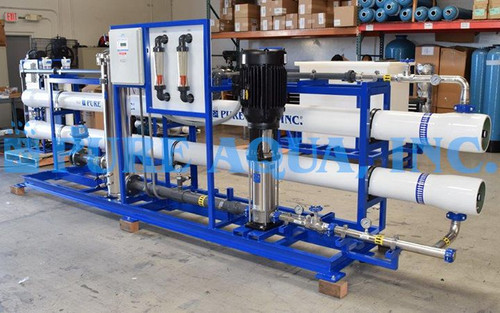Application: Hospital Use
This is model MLF-42A, ACF-60A, WS30-450-2T & RO-9000 from our RO-200 Series.
- Media filter
- Carbon filter
- Water softener
- Reverse osmosis system
- UV sterilizers
- 0.2 micron filter
- Duplex multi-media filter
- Duplex carbon activated filter
- Twin alternating water softener
- Produce: 58,000 GPD
- Feed TDS: 1,500 PPM
In the hemodialysis units of the water treatment package, reverse osmosis is designed to purify water as much as possible for the use of dialysis. Water is required to be of the highest purity for this medical treatment because of the increased risk of passing impurities from water to blood. During dialysis, pure water comes into direct contact with blood and used to collect impurities from a patient’s blood. Note the severe need for the water to be as pure as possible. Reverse osmosis systems contributes to the purity of the water because it is the process in which impurities are removed by forcing water to go against its natural tendencies. As stated above, water is forced by pressure to move toward a lower concentration. The water is also forced through membranes that contribute to the purification of the water. In the case of hemodialysis units, the membranes that are used are called spiral wound reverse osmosis membranes. These membranes have up to 99.4% rejection level of impurities. Rejecting more hardness, impurities and bacteria than any other type of membrane. They produce the highest purity of water that is demanded for the needs of dialysis.
A commercial reverse osmosis device was designed and manufactured in order to remove salts and impurities from water. As a result of removing the content, the water is purified and capable for usage. “Osmosis” is the natural processes in which water with a low salinity concentration is attracted to that with a higher salinity concentration. Reverse osmosis contraries the natural process. The water is forced toward low salinity concentration by applying a great amount of pressure. The amount of pressure must exceed that of the natural occurring osmosis. The water is then pushed through semi porous membrane. Semi porous can be defined as allowing some passage way, which in reverse osmosis case, would be water. The membrane allows the water through its “wall” while impurities and salts are left to remain on the opposite side as the now pure water. The semipermeable membrane is made up of many layers of filters. These filters vary in types of substance but have the same commonality of holding back toxins from the water. The impurities then continue in a separate cycle becoming waste. The water then becomes pure and can be fed through a line to whatever use desired.
The service building is made up of filters and softeners contribute to the ultimate purifying of water that will eventually be used during dialysis. Multimedia filters are assembled with different texture and size of media in order to catch the most possible impurities. Because these media are intermixed, the entire filter has the capability to catch impurities. This helps the filter have a longer lifespan as well as increases efficiency. Along with the usage filters, the service building uses a water softener. A water softener removes hardness caused by calcium and magnesium with a combination of resin covered in sodium ions. The water is filled into the softener where the calcium and magnesium attract to the resin, then the sodium ions are released and continued down the process with the water. Once the resin is full of calcium and magnesium, the softener needs to regenerate. Regenerating is when a solution full of sodium ions is poured into the softener. The sodium ions now attract to the resin while the calcium and magnesium are released and go with the concentrated water to be discarded. The softener that was being used switches to regeneration mode while the softener that was regenerating starts purifying using the same process. The idea that one softener works, while one regenerates is known as twin alternating water softeners.
[custom-specifications]
Water Challenges: Pure water is hard to find in the world considering that the majority of the world’s water is in oceans and water cannot really be created. Reverse osmosis makes it easier for those around the world to continue each day. The body needs water to subsist and by providing pure water to those who need it, the survival rate is increasing. Pure water is crucial not only in the medical field but also in agriculture and business. The demand for pure water is high and reverse osmosis helps combat the desperate need.
[/custom-specifications]
[custom-features]
Applied Solution: In May 2009, Pure Aqua, Inc. successfully manufactured and Water Treatment Package to a major hospital in Jordan. The product water capacity was 58,000 GPD from well water of approximately 1,500 ppm TDS. This water treatment package contains a couple different sections. The service building contained a 42” Duplex Multimedia Filter, 60” Duplex Activated Carbon Filter and 30” Twin Alternating Water Softener. The Hemodialysis Unit contains a media filter, carbon filter, water softener, reverse osmosis system, UV sterilizers, and a 0.2 micron filter. Since its initial startup, the commercial RO device has been operating accordingly with minimal trouble-shooting.
[/custom-features]
[custom-usage]
- Minimal civil work and construction
- Small footprint
- Plug and play installation
- High-quality components (Grundfos pumps, DOW Filmtec membranes, Codeline vessels, Pure Aqua microprocessor control panel)
- High recovery design
- High rejection membranes
- Low energy and chemical consumption
Reverse Osmosis System 58,000 GPD for Hospital use - Jordan - Case Study [/custom-documents]
-
Great quality
We have complete the complete Reverse Osmosis System. The quality is really great on all equipment provided.
 ENGLISH
ENGLISH ESPAÑOL
ESPAÑOL العربية
العربية PORTUGUÉS
PORTUGUÉS FRANÇAIS
FRANÇAIS













